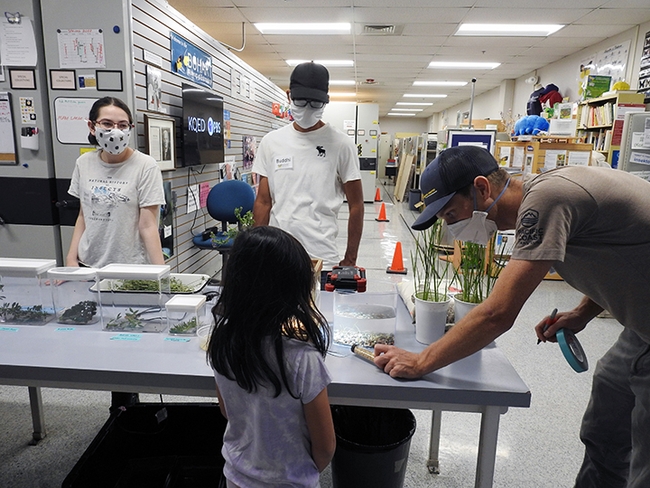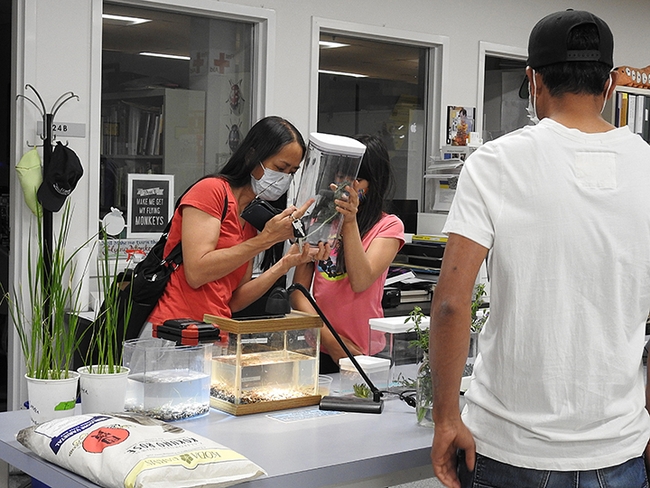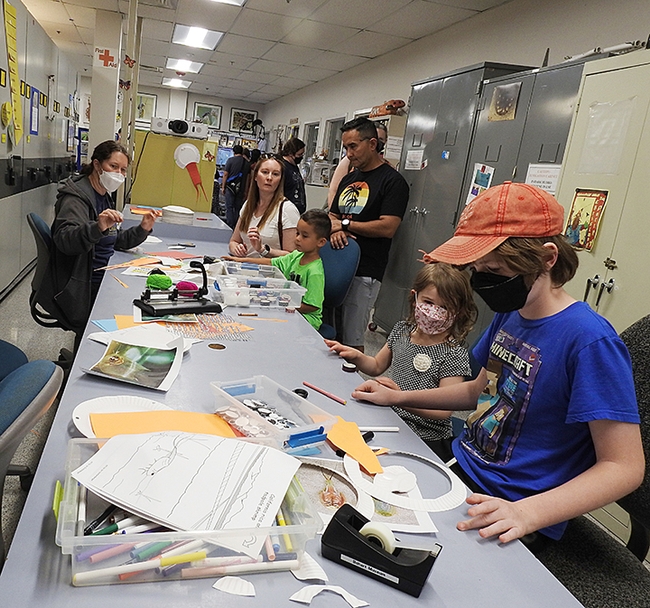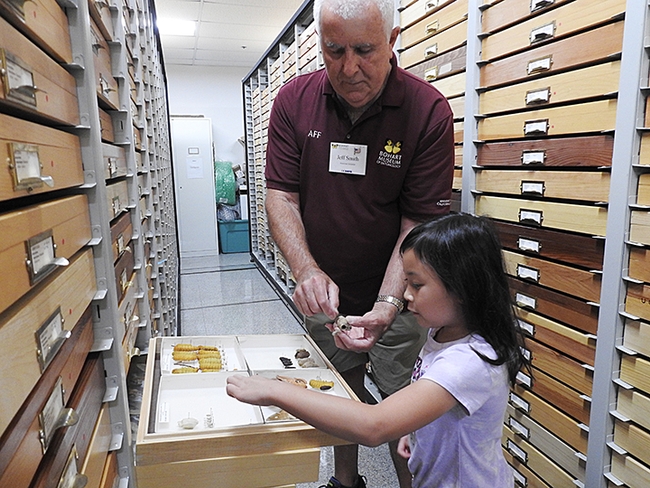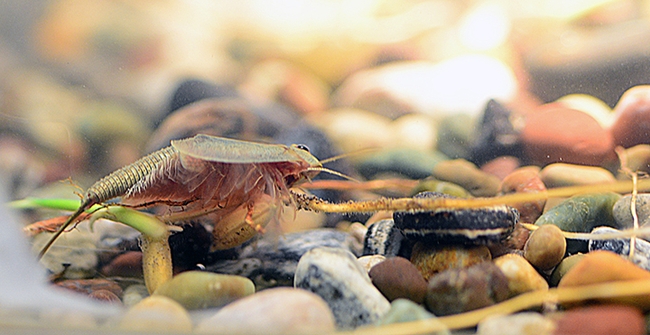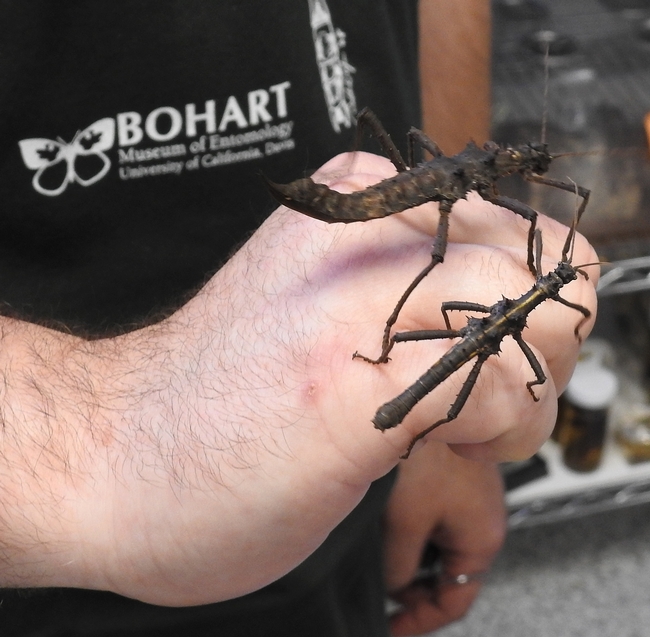- Author: Kathy Keatley Garvey

My inaugural Bug Squad blog on Aug. 6, 2008 dealt with a swarm of bees that "hitched" a ride on Aug. 1 from El Cerrito to UC Davis on a commuter van.
"At 7 a.m., a group of UC Davis employees approached their commuter van in an El Cerrito parking lot. But, after glancing at the passenger side, they weren't at all sure they wanted to board. A huge swarm of bees bearded the entire passenger side of the vehicle and part of the windshield. Thousands of bees. Did I say thousands of bees? Thousands of bees."
"What to do? Knowing about colony collapse disorder and the declining bee population, they didn't want to hurt them. So they climbed in the van via the driver's side and circled the block, hoping the bees would disperse. They didn't."
"In an un-bee-lievable sight, the white van, accompanied by the bees and their queen, buzzed to the UC campus on a 60-mile freeway ride. When the vehicle pulled into the Shields parking lot shortly before 8 a.m., so did a long line of bees hanging around the door frame."
“We lost most of them along the way,” vanpool driver Keir Reavie, head of the Biological and Agriculture Sciences Department at Shields Library, told us.
How did the survivors survive?
That was the question.
Cooperative Extension apiculturist Eric Mussen, based in the UC Davis Department of Entomology (it's now the Department of Entomology and Nematology) explained that "some bees must have slipped inside the door frame and held on to the others by linking legs. The queen bee was probably inside the crack.”
Mussen recommended that the commuters leave them alone or contact a beekeeper on campus or in El Cerrito to vacuum off the swarm. “The bees in a swarm usually won't bother you unless they are significantly disturbed,” he said.
Meanwhile, the social insects spent the day on campus, periodically leaving the van for food and water, while others—the scouts—searched for a new home. Some bees parked on the “Van Pool Parking Only” sign and the motorcycle permit parking sign. A spider took the opportunity to snack on a bee snared in its web.
So many memories.
And so many memories of the incredible Eric Mussen, who died June 3 at age 78 after being diagnosed with liver cancer on May 31. We are all grieving and heartbroken over the tremendous loss of our friend, colleague and fellow human being who loved bees and delighted in sharing information about them.
Mussen, who served as the state's Extension apiculturist for 38 years, joined our Department of Entomology in 1976, and retired in 2014. But he never really retired. He kept busy during his retirement years with his various projects, including serving as the 2017 president of the Western Apicultural Society for the 40th anniversary conference at UC Davis.
He gained state, national and international stature for his expertise on bees and his skills as a science communicator. You may have heard him on National Public Radio (Science Friday) or on BBC or read about him in the nation's top newspapers. (Read the tributes from colleagues, fellow scientists, bee breeders and beekeepers on the Department of Entomology and Nematology website.)
For nearly four decades, Eric drew praise as “the honey bee guru,” “the pulse of the bee industry" and "the go-to person" when consumers, scientists, researchers, students, and the news media sought answers about honey bees.
“Eric's passing is a huge loss," said longtime colleague Lynn Kimsey, director of the Bohart Museum of Entomology and a UC Davis distinguished professor of entomology. "He was always the go-to person for all things honey bee. He worked happily with hobbyists, commercial beekeepers and anyone just generally interested."
Eric was, indeed, the "go-to" person for all things honey bee.
"I was such a fan of Eric and he was an educator of everything honey bees and an all-around great guy," Christine Souza, assistant editor of Ag Alert, told us this morning. "For many years he was an amazing source for me for Ag Alert. No one had the knowledge or charisma that he had to talk about entomology and make the average person out there listen to scientific information. He was great at it and made me want to learn more about bees every time I had the great opportunity to talk to him. I feel very blessed to have met him and interviewed him."
We were all blessed. It was a honey of a ride and he left a whale of a legacy.
(A Celebration of Life for Eric Mussen is planned from 4 to 6 p.m., Sunday, Aug. 28 in the Putah Creek Lodge, UC Davis campus.)

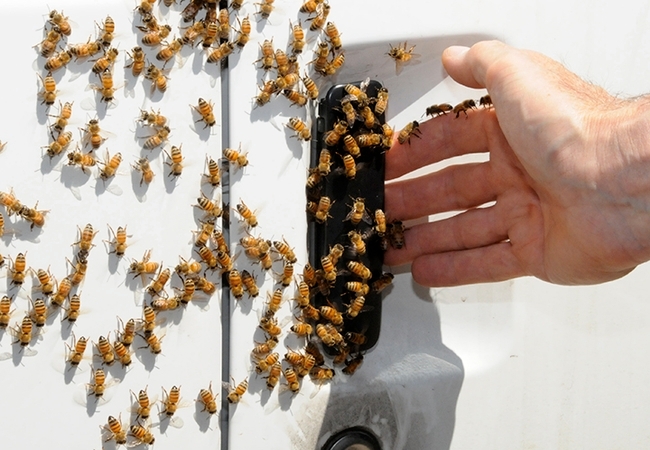
- Author: Kathy Keatley Garvey
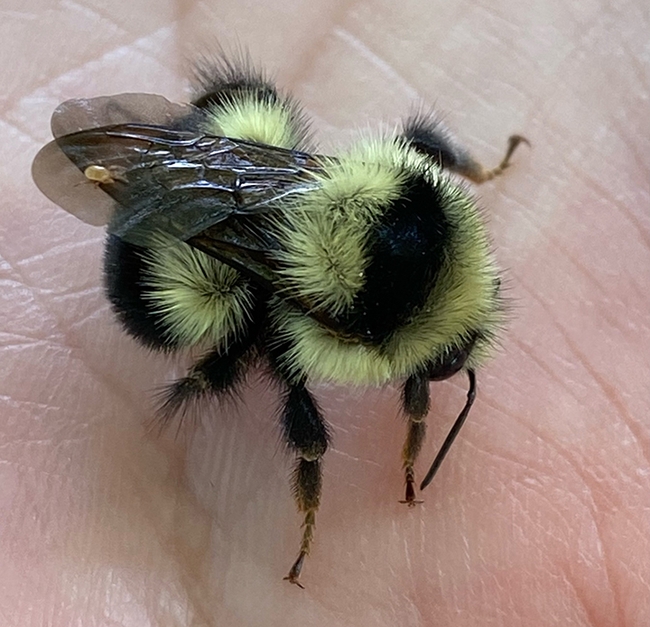
The Atlas, a community-science collaboration launched in March 2022 by the California Department of Fish and Wildlife (CDFW) and the Xerces Society for Invertebrate Conservation, seeks to track and learn more about California's native bumble bees. The Atlas is training citizen scientists to collect data to help conserve declining species.
"It was a small event but lots of fun," said tour leader Dylan Winkler, bumble bee scientific aide for the CDFW's Wildlife Diversity Program. He works closely with senior environmental scientist and pollinator coordinator Hillary Sardiñas of CDFW's Wildlife Diversity Program. She formerly worked for Xerces.
Winkler conducted the 10 a.m. field day on Saturday, May 28 and invited the public to participate.
"The event was really fun!" said participant and community ecologist Danielle Rutkowski, a doctoral candidate who studies with Rachel Vannette, associate professor, UC Davis Department of Entomology and Nematology. "We were able to catch three different bumble bee species, the yellow-faced bumble bee (Bombus vosnesenskii), the black-tailed bumble bee (Bombus melanopygus) and a few individuals of Bombus fervidus (commonly known as the golden northern bumble bee)."
"We spent some time going over survey methods and capture technique, and then caught some individuals and practiced taking photographs before releasing them," Rutkowski said. "It was a really great opportunity to see the abundance and diversity of bumble bees even in one small area of campus, and I'm really excited to get involved in some surveys in the Sierra, where diversity can be much higher!"
Rutkowski completed her bachelor's degree at Cornell University, where she studied how the relationship between mycorrhizal fungi and their host plants impacts insect herbivores. She currently studies “how bumble bees interact with the microbes, particularly fungi, in their environment, and how these relationships impact bee health.”
Winkler said the group netted a total of 15-20 bumble bees, representing the three species. "We also saw a few more. They were mostly on different salvia species, California poppies, and a native Solanum, the bluewitch nightshade. Surprisingly, there were also a couple on lavender and ceanothus."
Cindy McReynolds, an administrator and research scientist in the laboratory of UC Davis distinguished professor Bruce Hammock of the Department of Entomology and Nematology and Comprehensive Cancer Center, and who directs research at the Hammock-founded EicOsis, participated with her son, Elliot McReynolds, 13.
"We both are looking forward to working on the Atlas project," said McReynolds, who holds a doctorate in pharmacology/toxicology. "He is already hedging trips to the coast and mountains to look for bees."
Bumble Bee Alert. Back in September 2021, the U. S. Fish and Wildlife Service announced that the American bumble bee, "whose populations have plummeted by nearly 90 percent, may warrant Endangered Species Act protection." The announcement kicked off a one-year status assessment of the species. (See news story)
The California Bumble Bee Atlas is planning more field days to train citizen-scientists:
- Saturday, June 4: The Gardens at Lake Merritt, 666 Bellevue Avenue, Oakland, CA (Alameda County). Tour of the gardens from 9 a.m. to 11 a.m.
- Sunday, June 5: College of Marin at Kentfield (Marin County), parking at covered Lots 6/7 off College Ave, Kentfield, CA 94904. Details: Meet at bridge over Corte Madera Creek. Tour of the campus native plants from 10 a.m. to noon.
- Saturday, June 18: Soil Born Farms, Rancho Cordova, CA (Sacramento County), parking at Soil Born Farms: American River Ranch, 2140 Chase Drive, Rancho Cordova, CA 95670. As part of National Pollinator Week, the group will tour the gardens from 10 a.m. to noon. Closed-toed shoes required.
To register or to obtain more information, access https://arcg.is/0PDyO4.
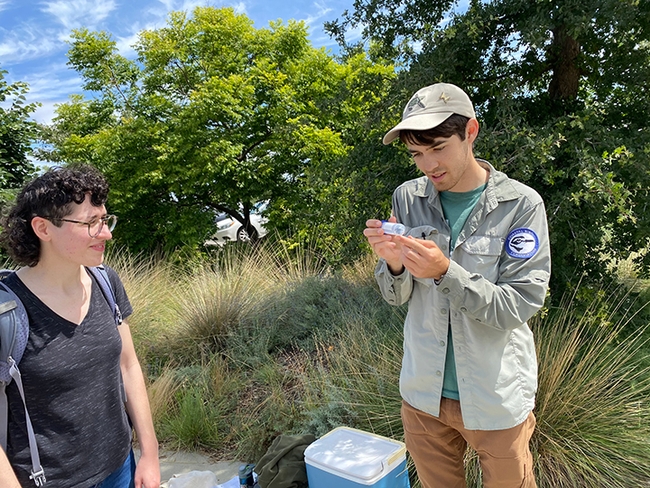
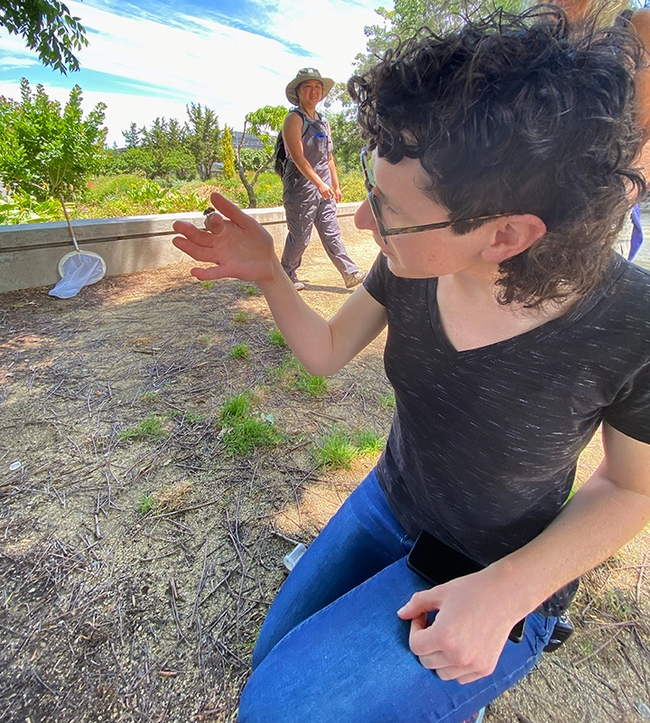
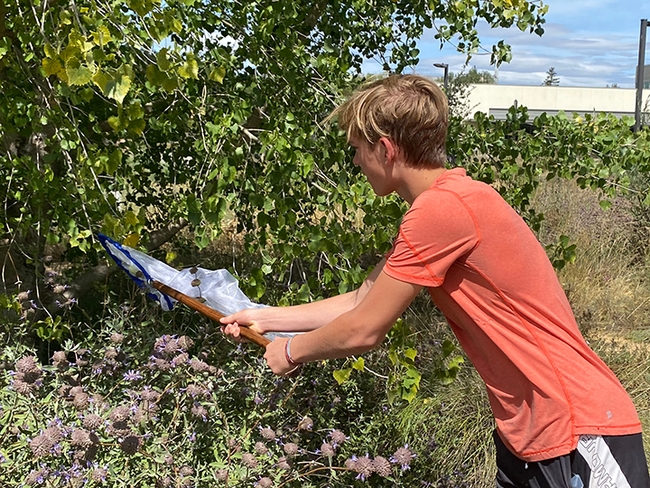
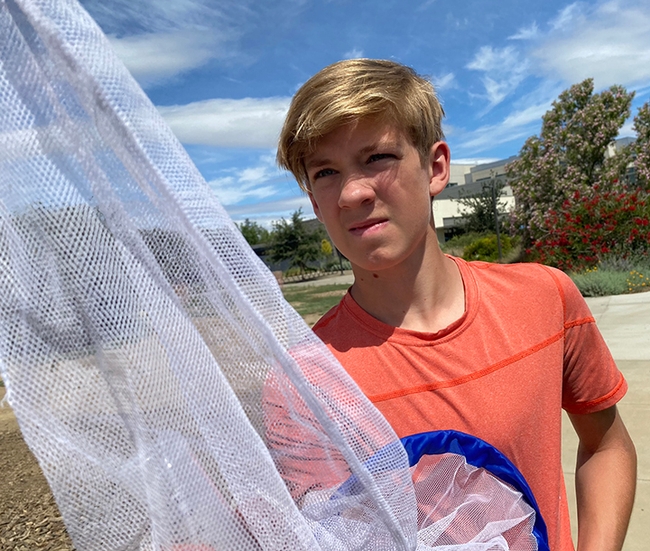
- Author: Kathy Keatley Garvey
Seen any European wool carder bees lately?
European wool carder bees (so named because the female collects or cards plant hairs for their nests) are on the move.
The bees, about the size of honey bees, are mostly black and yellow. The females range in body length from 11 to 13 millimeters, while the males are 14 to 17 mm.
The males are known for being very territorial. They body-slam other insects to protect their turf, per chance to mate with the females.
The European wool carder bees, Anthidium manicatum, are natives of Europe. Their "immigrant ancestor" was first detected in the United States (New York) in 1963, and the species then began spreading west. The bees were first recorded in California (Sunnyvale) in 2007.
The species, according to research entomologist Tom Zavortink of the Bohart Museum of Entomology at UC Davis, was accidentally introduced into New York state. They were not purposefully introduced to pollinate alfalfa, as some reports allege, he said.
Writing in a 2008 edition of the Pan-Pacific Entomologist, Zavortink and fellow entomologist Sandra Shanks, now of Port Townsend, Wash., pointed out that several papers “have documented its spread from neighboring areas in the northeastern United States and southern Canada” and that the species has since crossed the country. It was confirmed in Colorado in 2005, Missouri in 2006, and Maine, Michigan, Maryland and California (Sunnyvale) in 2007, the entomologists wrote. Records show it was first collected in Davis on July 26, 2007.
It was well established in the Central Valley by 2008, according to Lynn Kimsey, director of the Bohart Museum of Entomology and a UC Davis distinguished professor of entomology.
We first encountered the European wool carder bee in Vacaville, Solano County, in the spring of 2010. Its plant preferences include lamb's ear (Stachys byzantine, in the mint family Lamiaceae), a perennial grown for its fuzzy, silvery gray-green foliage. It's also been collected in the figwort/snapdragon family (Scrophulariacae) and the pea and bean family (Fabaceae), according to the Zavortink-Shanks research.
In our pollinator garden, they seem to prefer foxgloves, lamb's ear, catmint and lavender. Yes, in that order...
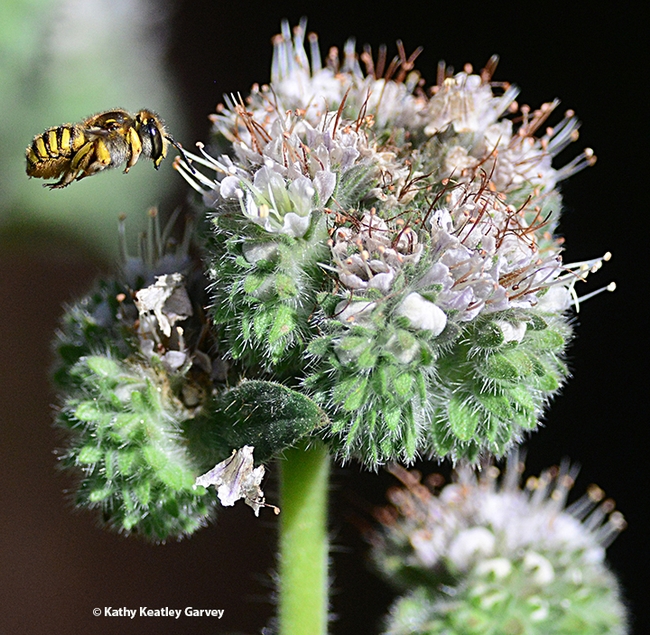
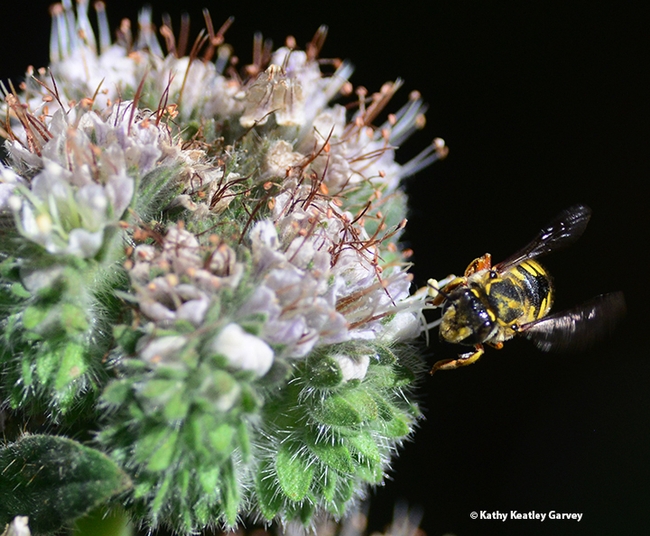
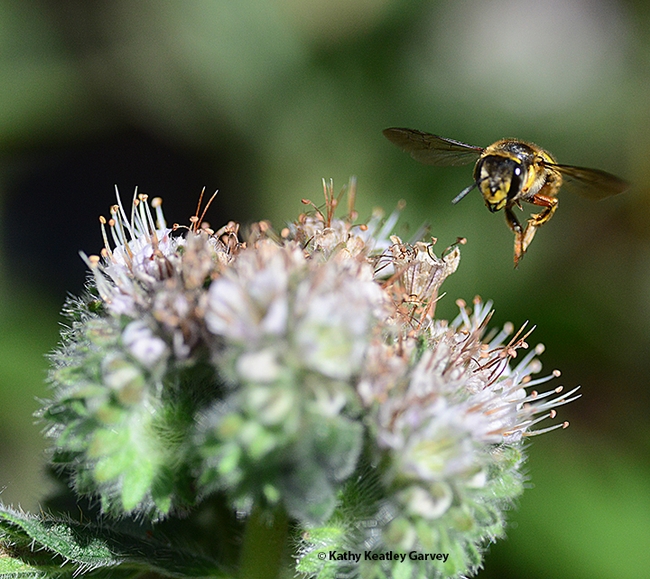
- Author: Kathy Keatley Garvey
Shapiro, a 50-year member of the UC Davis faculty, says that "Although it is a significant alfalfa pest, this butterfly overwinters as a larva almost entirely in annual vetch at low altitudes, and colonizes alfalfa only as the vetch senesces in May-June. Aside from alfalfa and annual vetches, it also breeds on a variety of clovers and sweet clovers and occasionally on lupines."
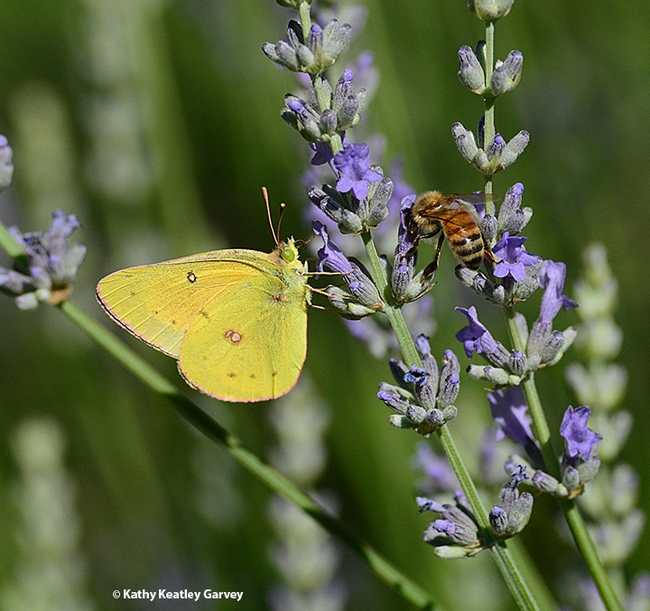
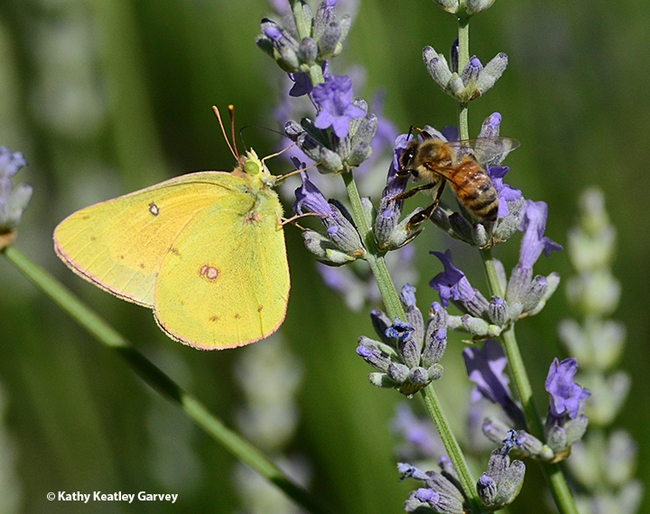
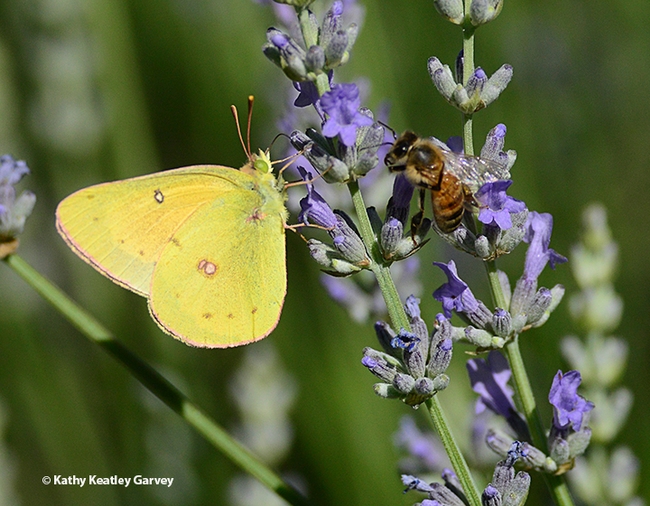
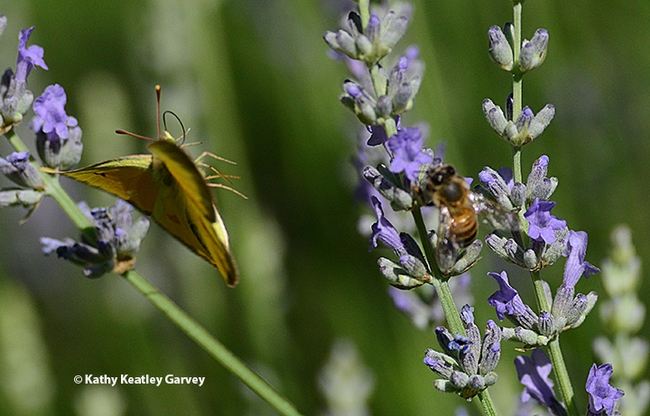
- Author: Kathy Keatley Garvey
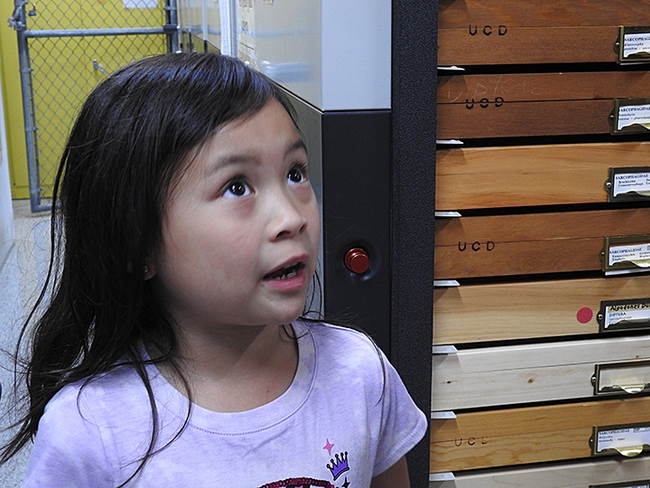
They crafted tadpole shrimp-themed hats and puppets using paper plates and googly eyes.
And they asked questions. Lots of questions.
It was all part of the UC Davis Bohart Museum of Entomology open house, themed "Bugs in Ag: What Is Eating Our Crops and What Is Eating Them?" The event, held May 28 and free and open to the public, drew dozens of visitors ranging from toddlers to senior citizens.
Cooperative Extension specialist Ian Grettenberger, an agricultural entomologist with the UC Davis Department of Entomology and Nematology faculty, and postdoctoral fellow Buddhi Achhami of the Grettenberger lab displayed pests of rice and alfalfa--as well as beneficial insects--and fielded questions. Bohart Museum volunteer and undergraduate student Omri Livneh assisted.
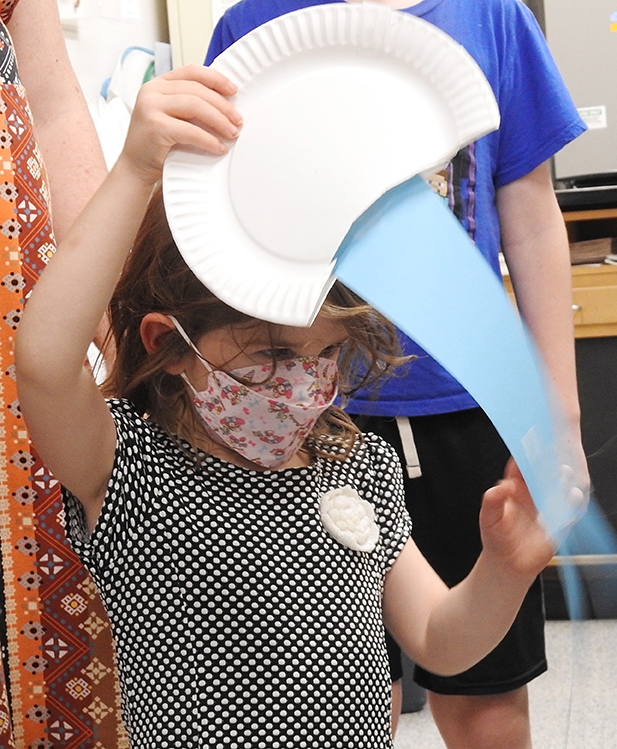
The Grettenberger lab showed KQED's Deep Look video, Tadpole Shrimp Are Coming For Your Rice. which includes Grettenberger's expertise.
"People enjoyed the event and learned about rice and agricultural pests, thanks to the Grettenberger lab special displays," commented Tabatha Yang, Bohart Museum's education and outreach coordinator who organized the event. She credited UC Davis doctoral student Grace Horne of the Emily Meineke lab with loaning additional USB scopes.
Entomologist Jeff Smith, who curates the Lepidoptera collection, showcased butterfly and moth specimens, including Atlas moths and monarchs. He marveled at the knowledge of "budding scientist" 6-year-old Riley Laurel of Vacaville, who arrived with her father, Julius, and brother, Aidan, 2. It was their first visit to the Bohart Museum.
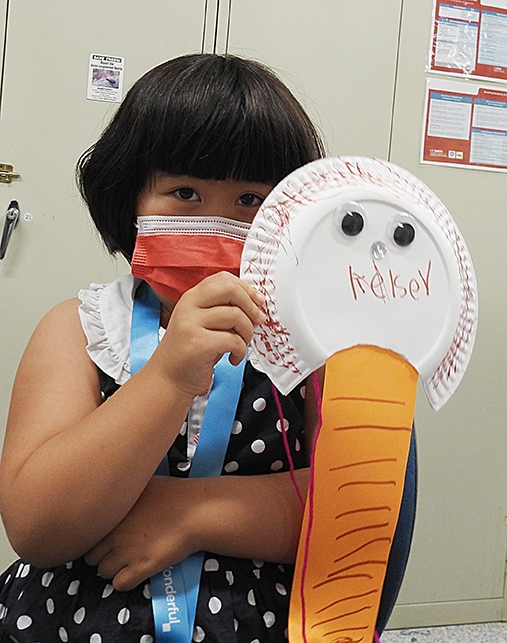
Bohart volunteer Barbara Heinsch, UC Davis graduate and environmental scientist and Chew staffed the arts and crafts table. Ellie Lindquist, 4, of Woodland and Kelsey Meng, 5, of Davis expressed delight in making tadpole shrimp-themed creations.
The Bohart Museum, directed by Lynn Kimsey, UC Davis distinguished professor of entomology, houses a global collection of eight million insect specimens; the petting zoo; and a year-around gift shop (also online), stocked with insect-themed gifts, such as t-shirts, hooded sweatshirts, posters, jewelry, books, puppets, candy and collecting equipment. It is located in Room 1124 of the Academic Surge Building, Crocker Lane.
The next open houses are scheduled June 25 and July 16. Like all of the Bohart Museum open houses, they are free and open to the public.
- Saturday, June 25, 1 to 4 p.m.
"8-Legged Wonders"
This open house is all about arachnids (think spiders) and will feature scientists from across the country. It is being held in collaboration with the American Arachnological Society's 2022 meeting, June 26-30m on the UC Davis campus and hosted by Jason Bond, the Evert and Marion Schlinger Endowed Chair in Insect Systematics, UC Davis Department of Entomology and Nematology, and associate dean, College of Agricultural and Environmental Sciences, and Joel Ledford, assistant professor of teaching, Department of Plant Biology, College of Biological Sciences. Arachnids also will be discussed at a public session on Tuesday, June 28, from 7:30 p.m. to 9 p.m. in California Hall. - Saturday, July 16, 1 to 4 p.m.
"Celebrating 50 years of the Dogface Butterfly: California's State Insect"
Scientists will join the public in celebrating the 50th anniversary of the California State Legislature' designation of the dogface butterfly, Zerene eurydice, as the state insect. Found only in California, the butterfly thrives in the 40-acre Shutamul Bear River Preserve near Auburn, Placer County. The preserve is part of the Placer Land Trust and is closed to the public except for specially arranged tours. At the July 16th open house, Folsom Lake College professor and Bohart scientist Fran Keller, and Bohart associate Greg Karofelas, a volunteer docent for the Placer Land Trust's dogface butterfly tours, will discuss the butterfly. Keller, who holds a doctorate in entomology from UC Davis, authored the 35-page children's book, The Story of the Dogface Butterfly (with photos by Keller and Kareofelas, and illustrations by former UC Davis student Laine Bauer.) Kareofelas and Keller also teamed to create a dogface butterfly poster of the male and female. Both the book and the poster are available online from the the Bohart Museum of Entomology gift shop. (Read more on how the butterfly became the state insect under the Ronald Reagan administration.)
